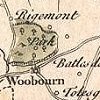Ridgmont
Timeline
Places > Ridgmont
 1220: First recorded vicar of Segenhoe Church.
1220: First recorded vicar of Segenhoe Church.
1803: Ridgmont Enclosure Award.
1811: Baptist Chapel built.
1853: Methodist Chapel built.
1854: Village School built.
1854-55: All Saints church built to replace the original parish church at Segenhoe. The new church was built to the designs of George Gilbert Scott, chiefly at the expense of the Duke of Bedford. After the new church was opened the old church was retained as a mortuary chapel. The new church did not have a separate burial ground and the churchyard at Segenhoe remained in use. The chancel of Segenhoe church dates from the 11th century and the chancel arch and south side of the church are Norman work of a slightly later date. By 1853 Segenhoe church was in need of substantial repair and the decision was made to build a new church in a more convenient site.
1896: The Farm School opened, run by Bedfordshire County Council, the school continued until 1913. The Farm School at Warren Farm was a school for training boys in agriculture.
1935: Ridgmont brickworks at Brogborough opened, built by Ridgmont Fletton Brick Company.
1963: The White Hart Public House sold and became a private house.
1980: Segenhoe church formally declared redundant.
1982: The ruins of Segenhoe church were consolidated by Bedfordshire County Council.
c1991: Methodist Chapel converted into a private house.
2006: Work starts in November on the Ridgmont bypass. (Bedfordshire Times, 10th November)
Sources:
- The Newspaper Cuttings Collection in the Local Studies Library at Bedford Central Library
- Victoria County History of Bedfordshire 3 Vols. 1912.
- Pickford, C. Bedfordshire Churches in the 19th Century Part 2 H-R Bedfordshire Historical Record Society Vo. 77 1998
- Ridgmont: an Edwardian Cameo : the photographs of Jack Sharpe. 1991.
Page last updated: 3rd February 2014
